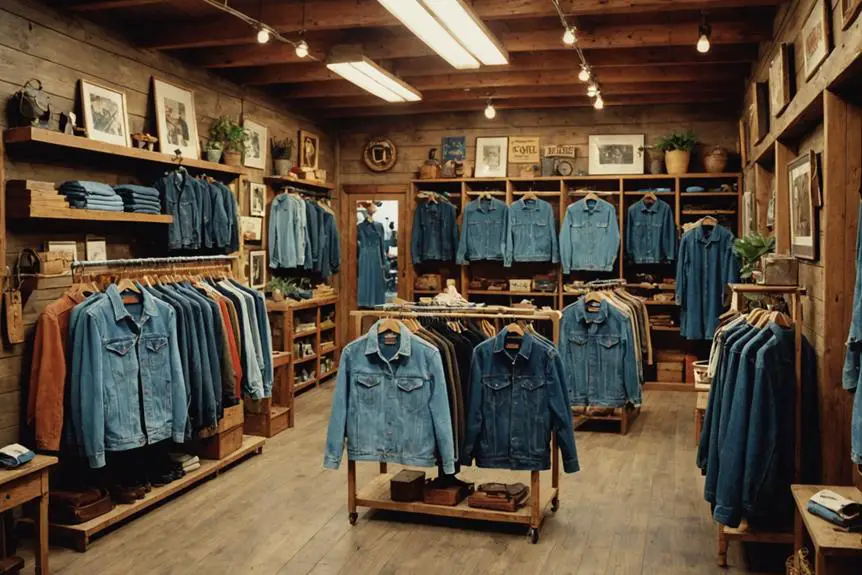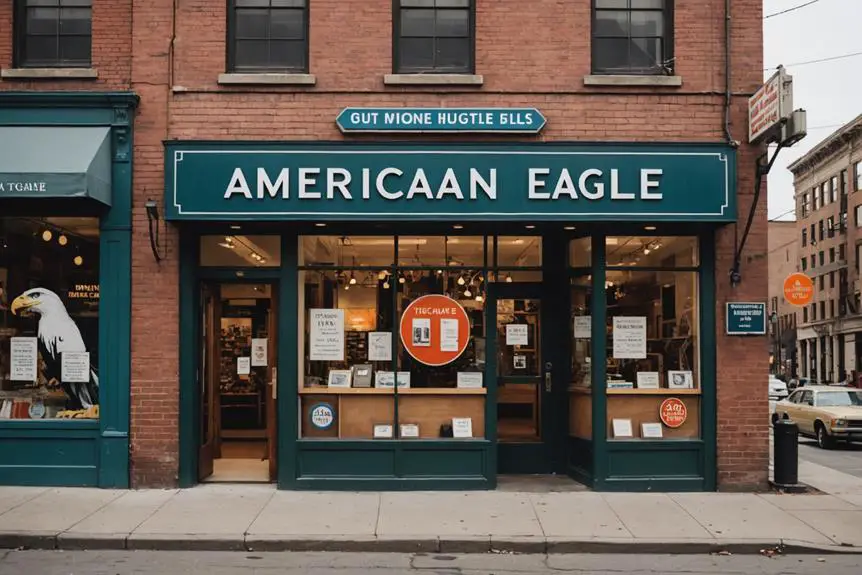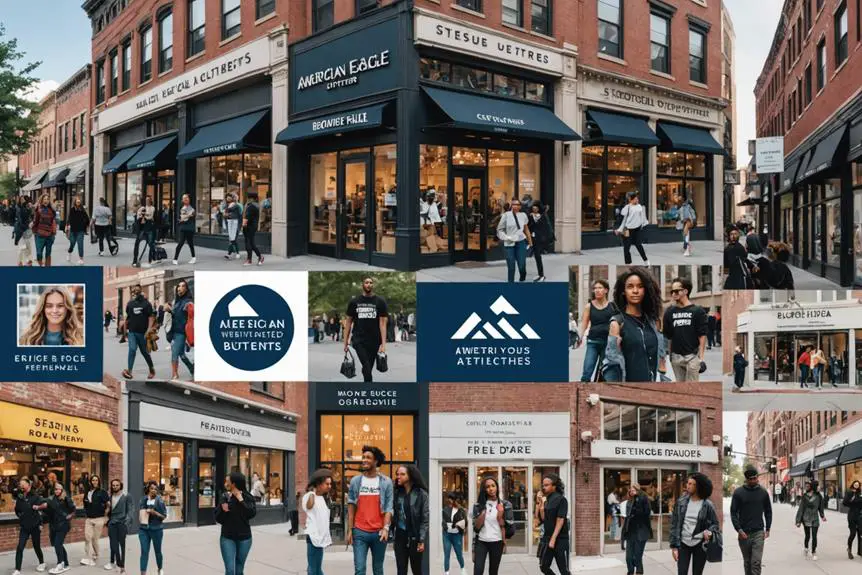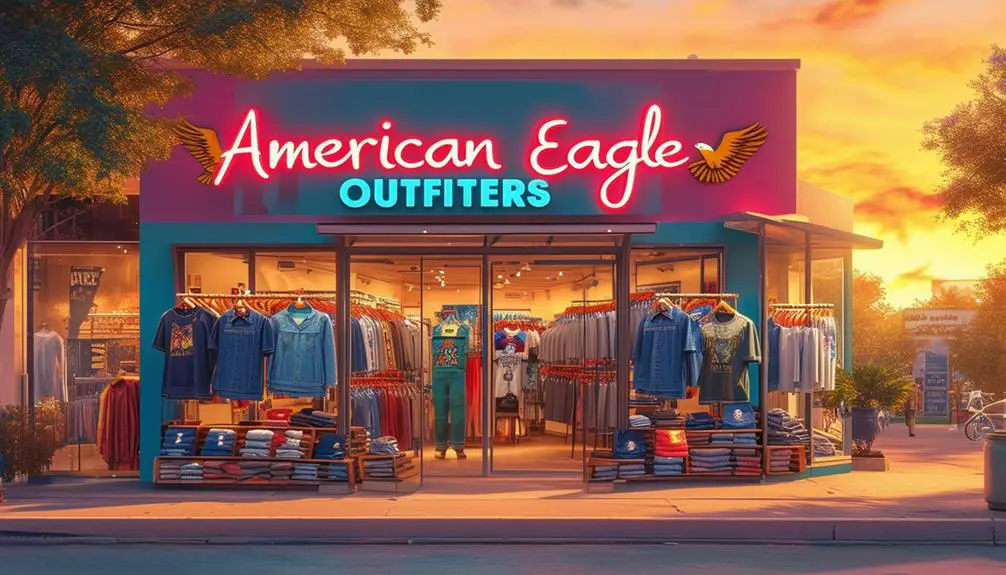American Eagle Outfitters began its journey in 1977 as a division of Silvermans Menswear, focusing on casual wear for young adults. Over the years, the brand evolved its strategies, going public in 1994 and reaching an impressive $1 billion in revenue by 2000. As the brand expanded onto the international stage, it faced various challenges, including unsuccessful ventures and controversies surrounding labor practices. However, innovation remained at the forefront, leading to the creation of Aerie, a line dedicated to body-positive apparel. Today, American Eagle Outfitters operates more than 1,180 stores globally, continually adapting to shifting market trends and consumer preferences. Delve deeper to uncover the story behind their resilience and distinctive growth strategies.
Founding and Early Years

American Eagle Outfitters emerged in 1977, when Jerry and Mark Silverman launched it as a division of Silvermans Menswear in Novi, Michigan. Initially, the Silverman brothers focused on casual and sportswear, aiming to attract young adults through their retail stores in multiple malls. This strategic targeting allowed American Eagle to carve out a niche in the burgeoning youth apparel market.
However, the early years weren't without challenges. The company faced financial struggles, which prompted the Silverman brothers to explore alternative distribution methods, including entering the mail-order clothing industry. This move was pivotal, as it expanded American Eagle's reach beyond traditional retail stores.
In 1980, a significant ownership change occurred when the Silverman brothers sold half of the company to Schottenstein Stores, a move that would stabilize the brand's finances. By 1989, after several restructurings and a renewed focus on the American Eagle brand, it had solidified its position as a key player in the casual wear market. The evolution from a mall-centric retailer to a recognized brand set the stage for American Eagle's future growth and innovation.
Company Overview and Structure
Operating under the NYSE ticker symbol AEO, American Eagle Outfitters maintains a diverse and well-structured corporate framework designed to support its extensive retail operations. Founded in 1977, this company has evolved into a global player with 1,182 stores across various countries as of February 2024. It primarily targets young adults, offering a wide range of casual wear and denim lines that resonate with its audience.
American Eagle Outfitters serves as the parent organization for several successful subsidiaries, including Aerie, which focuses on intimate apparel and loungewear, and Unsubscribed, known for its trendy selections. This multi-brand approach allows the company to cater to different market segments while maintaining a cohesive identity in retail.
The strategic organizational structure enables American Eagle Outfitters to leverage its resources effectively, ensuring each brand operates under its unique business model while benefiting from shared operational efficiencies. As part of the S&P 600 index, the company's solid financial standing reflects its adaptability and commitment to innovation within the competitive retail landscape. This framework positions American Eagle Outfitters to continue thriving in an ever-evolving marketplace.
Development History and Financial Performance

Since its inception, American Eagle Outfitters has undergone notable transformations that have shaped its financial trajectory and brand identity. Initially focused on brand-name leisure apparel and footwear, the company shifted its strategy in 1989 after divesting other retail chains. This strategic pivot laid the groundwork for future growth. Going public in 1994 with 167 stores marked a turning point, notably boosting cash flow and enabling rapid expansion; revenues quintupled to $1 billion by 2000.
In 2013, American Eagle reported a 3% gain in Q2 profits, signaling a recovery in financial performance after previous challenges. However, the company faced setbacks, including a major restatement of results in January 2015. To enhance operational efficiency, American Eagle acquired Quiet Logistics for $350 million in November 2021, demonstrating a commitment to improving supply chain capabilities.
The pandemic further accelerated e-commerce sales, reflecting American Eagle's ongoing adaptation to shifting consumer behaviors and preferences. As you analyze these developments, it becomes clear that American Eagle's financial performance hinges on its ability to evolve while maintaining its core brand identity.
Products and Brand Development
While traversing the ever-evolving fashion landscape, American Eagle Outfitters has successfully developed a diverse product range that resonates with its target audience. Their offerings include jeans, polo shirts, graphic T-shirts, and swimwear, catering to the casual wear market for both men and women.
The introduction of the Aerie sub-brand in February 2006 marked a significant milestone in brand development. Aerie focuses on intimate apparel and activewear, promoting body positivity and inclusivity. In July 2020, American Eagle expanded its product lines further by launching Offline by Aerie, targeting the fitness and leisure wear segment.
To adapt to consumer trends and seasonal themes, American Eagle consistently innovates its products. Through engaging marketing strategies tailored for Gen Z, they influence both product development and brand identity.
| Product Category | Launch Year | Target Market |
|---|---|---|
| Casual Wear | 1977 | Men & Women |
| Aerie | 2006 | Women (Intimates) |
| Offline by Aerie | 2020 | Fitness Enthusiasts |
| Activewear | 2015 | Teens & Young Adults |
| Seasonal Collections | Yearly | All Ages |
This strategic approach guarantees a relevant and appealing shopping experience.
Retail Environment and Store Design

The shopping experience at American Eagle Outfitters is carefully designed to complement its diverse product offerings. You'll notice the warm and inviting atmosphere created by wooden shelving, tables, and clothes racks that encourage exploration. This thoughtful store design isn't just about aesthetics; it's about engaging you as a customer. Flat-screen televisions and seasonal displays enhance your experience, making it feel more dynamic and interactive.
In AEO stores, the use of aesthetically pleasing wooden hangers elevates the brand image, contrasting with the basic black hangers found in AEO Factory stores. This attention to detail contributes to a cohesive retail environment that reflects the brand's identity. Additionally, the flooring—typically wood or concrete—adds a modern touch, making the space feel both stylish and approachable.
The layout of the stores is meticulously curated to reflect seasonal themes and promotions, directly influencing how products are displayed and offered. Each visit is an opportunity to experience something new, ensuring that your shopping experience remains fresh and enjoyable. Overall, American Eagle Outfitters' commitment to effective store design and engaging retail environments greatly enhances the way you interact with the brand.
International Expansion and Growth
American Eagle Outfitters' journey into international markets reflects its strategic vision for growth and brand expansion. This journey began in 2001 when American Eagle opened its first Canadian store following the acquisition of Dylex assets. From there, the brand made significant strides into the Middle East between 2010 and 2011, launching stores in key locations such as Kuwait, Riyadh, Dubai, and Lebanon.
Further international expansion occurred from 2012 to 2013 as American Eagle entered Asian markets, opening stores in Japan, Israel, and China. While the UK expansion in 2014 initially appeared promising, the operations were ultimately ceased by July 2017 due to underperformance, highlighting the unpredictable nature of international ventures.
More recently, American Eagle has continued its global growth trajectory, with new stores opening in Uruguay in 2023 and in Prague in 2020. This ongoing international expansion showcases American Eagle's adaptability and commitment to reaching diverse markets, despite previous setbacks. By strategically selecting locations and responding to regional consumer preferences, the brand aims to solidify its presence on the global stage and cater to an expanding customer base.
Challenges and Controversies

International growth isn't without its hurdles, and American Eagle Outfitters has faced a variety of challenges and controversies throughout its history. Understanding these issues helps you appreciate the complexities of the brand's journey. Here are some key points:
- Failed Launches: The attempts to capture new demographics with Martin + Osa and 77kids resulted in significant losses—$44 million and $24 million, respectively. Both brands were ultimately closed, reflecting misaligned market strategies.
- Worker Rights Controversy: In 2004, AEO faced a boycott initiated by UNITE HERE over alleged worker rights violations at a contractor. This controversy necessitated public clarifications from the CEO regarding the company's supplier relationships.
- Design Litigation: Since 1999, AEO has been involved in multiple lawsuits with Abercrombie & Fitch over design copying claims. Although AEO has successfully defended itself, these legal battles have highlighted the intense competition and pressures in the fashion industry.
These challenges and controversies illustrate the difficulties American Eagle Outfitters has navigated, shaping its trajectory and influencing future strategies in a volatile retail landscape.
Community Engagement and Impact
Community engagement plays an essential role in shaping the identity and mission of American Eagle Outfitters. Established in 1999, the American Eagle Outfitters Foundation exemplifies this commitment by focusing on education, environmental conservation, and young women's health initiatives. In 2014 alone, the foundation's charitable contributions surpassed $2 million, illustrating a significant dedication to community support and a desire to create a positive impact.
AEO enhances its community engagement efforts by partnering with organizations like Teach For America and Bright Pink, which allows them to address pressing social issues effectively. You'll find that the company actively encourages its associates to participate in various community initiatives and charitable activities. This fosters a culture of giving back, where employees feel empowered to contribute to meaningful causes.
Ultimately, AEO's community engagement efforts reflect a broader mission to promote sustainable and ethical practices within society. By investing in local communities and fostering collaboration with nonprofit organizations, American Eagle Outfitters not only strengthens its brand identity but also plays a vital role in driving positive change. Their approach underscores the importance of corporate responsibility in today's business landscape.
Leadership and Innovation

AEO's commitment to community engagement lays a solid foundation for its leadership approach, which thrives on innovation and creativity. By empowering associates, AEO has cultivated a culture where change is not just welcomed but actively pursued. Under the guidance of Schottenstein Stores Corp., the company shifted focus to private label offerings, which effectively attracted the teenage demographic.
Key aspects of AEO's leadership and innovation strategy include:
- Empowerment of Associates: AEO encourages employees to bring their authentic selves to work, fostering collaboration and creative problem-solving across departments.
- Innovative Design: Clint Groom's introduction of the Flex Design for men's jeans reflects AEO's commitment to enhancing product comfort and style, influencing the overall brand direction.
- Global Multi-Channel Strategy: The shift to a global retail business emphasizes the need for continuous innovation, positioning AEO to compete effectively on an international stage.
Through these initiatives, AEO not only strengthens its leadership but also reaffirms its dedication to innovation, ensuring the brand remains relevant and appealing to its core audience.
Frequently Asked Questions
What Is a Brief History of American Eagle Outfitters?
You're looking at a brand that transformed casual wear since its founding in 1977. It adapted through ownership changes, expanded its product lines, and embraced body positivity, now boasting over 1,180 stores worldwide.
What Are Some Interesting Facts About American Eagle Outfitters?
You might find it interesting that American Eagle Outfitters operates over 1,182 stores globally, launched the Aerie brand to promote body positivity, and has successfully entered diverse international markets despite facing challenges with some of its brands.
What Is the Origin of the American Eagle?
The American eagle symbolizes freedom and strength, originating from the bald eagle, a national emblem. It represents resilience in American culture, embodying ideals of independence, which resonate deeply with the nation's identity and values.
What Does American Eagle Outfitters Stand For?
American Eagle Outfitters stands for inclusivity, diversity, and self-expression. It prioritizes body positivity, authenticity, and community engagement, aiming to empower young individuals through stylish clothing while maintaining high standards of integrity and accountability in its practices.





Oh my goodness! Amazing article dude! Thank you,
However I am having problems with your RSS. I don’t know the reason why I cannot join it.
Is there anybody getting identical RSS issues?
Anyone who knows the answer will you kindly respond? Thanx!!
Capture more leads for your vintageclothingguides.com website by harnessing AI on Instagram. If you’re looking to boost more traffic, produce leads, and expand your brand’s reach, you can find more information and start a no-cost trial here: https://ow.ly/rFVi50WXAv7
This is an AI-powered Instagram growth service that:
-Boosts followers with targeted, premium audiences.
-Boosts engagement through advanced AI algorithms.
-Targets users based on hashtags and accounts they follow.
-Saves work by automating tedious Instagram tasks.
Our service focuses on real, organic growth—no bots, no fake followers. It’s perfect for brands like yours that want to transform Instagram into a lead generation machine. Better yet, our service is provided on a monthly subscription basis so you can opt out whenever you like. No contracts and a one-week free trial.